August 17. MOSHI TO LAKE MANYARA - "Northern Safari Circuit - Day One" We were scheduled to leave at 8:00 and at about ten 'til we were finishing breakfast when a man from the Kili Crown office arrived. He was neatly dressed and 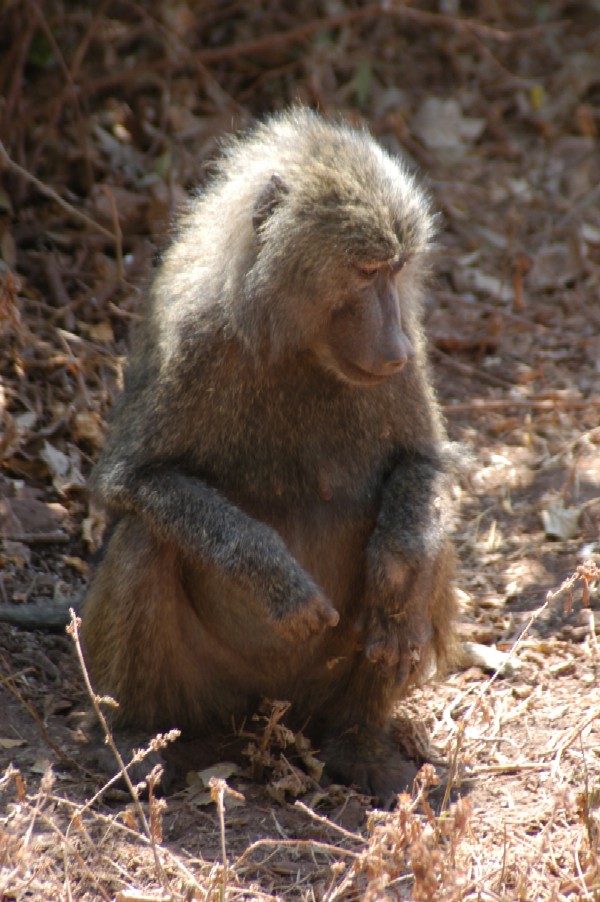 introduced himself as Mohammed. He had come to ask if we would mind a change in our itinerary. The other two people going on the tour wanted to visit Tarangire NP instead of going on the Maasai village tour on the last day. Visiting another park sounded like a bonus for us if it didn't increase the cost for us so we agreed. Mohammed told us someone would be around to pick us up shortly. introduced himself as Mohammed. He had come to ask if we would mind a change in our itinerary. The other two people going on the tour wanted to visit Tarangire NP instead of going on the Maasai village tour on the last day. Visiting another park sounded like a bonus for us if it didn't increase the cost for us so we agreed. Mohammed told us someone would be around to pick us up shortly.
As it started to approach 9:00 Rob called the office to find out what happened to our ride. They said the truck was on its way and at around 9:00 and dark green Land Cruiser pulled up in front of the YMCA. A tall guy came in and introduced himself as Bernard, our cook. Our driver and guide, Sisti, was waiting in the car. They apologized for being late and hoisted our bags into the truck. Then we were on our way to Arusha, where we would pick up the other two passengers.
It only took about an hour to reach Arusha and we were very observant as the truck drove into town. Arusha had a bad reputation for nasty touts and a newspaper article we had read in Zanzibar covered the increase in motorbike robberies targeting well-dressed people. One incident left the victim writhing on ground with a stab wound because he hadn't had enough money on him. On sight Arusha didn't look like such a bad place but is was much more chaotic and congested than Moshi. On the edge of down town we passed the large Arusha Conference Center, now home to the Rwanda War Crimes Tribunal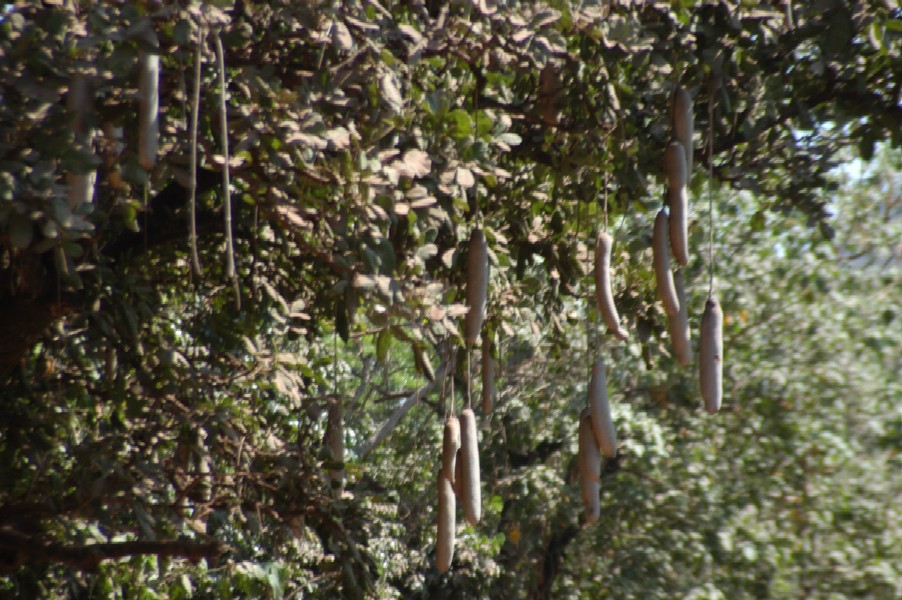 . The truck pulled down a street in the central business district and touts started to swarm around us, tapping on the window and holding up various items for sale. We were glad that we didn't have to get out. . The truck pulled down a street in the central business district and touts started to swarm around us, tapping on the window and holding up various items for sale. We were glad that we didn't have to get out.
The other couple, a pair of Germans, were waiting on the curb when we pulled up. They already looked disgruntled. We soon learned that they had been through a number of hassles trying to sort out this safari. The sleazy guy who was helping them came up and was just too friendly and fake when he introduced himself. He began talking to Sisti in Swahili and I could see Sisti shake his head. This last minute manipulation of trip itineraries was all too common and the guide then had to deal with sorting out a mess he didn't create. The Germans had signed up for a slightly different itinerary and actually only paid for a three day/four night safari, not a four day/five night trip. We discussed the expectations that we each had and were able to agree on what worked for everyone. Basically we would stick to what Mohammed had told us and start with Lake Manyara, where they would stay at camp because it wasn't in their itinerary, then we would go to the Serengeti, the Crater, and leave Tarangire for the last day. While Sisti and the sleazy guy were trying to sort it out we just put a foot down and told them this was how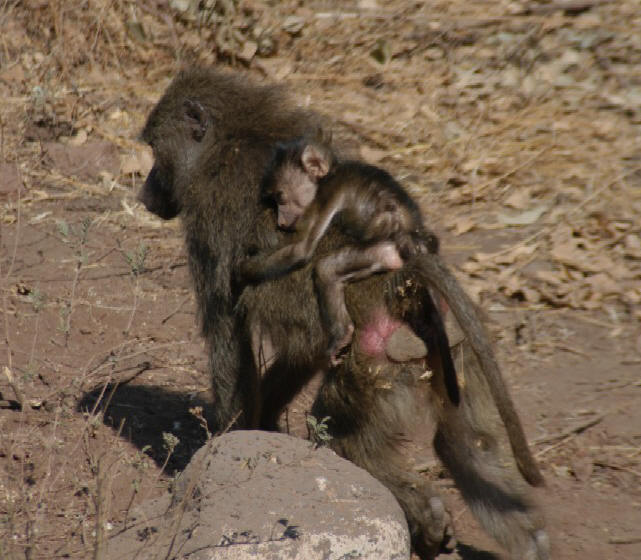 we were going to do it. we were going to do it.
Heading out of Arusha we made three more stops which started to make us feel the day was getting away from us. We had to pick up the lunch boxes, make a run at Shoprite for food, and fill up on gas again. We had made one gas stop en route from Moshi but they didn't have all of the money yet and couldn't fill the tank completely. Finally, we were leaving Arusha by around 11:30. The roads were in good condition but Sisti was much more careful about his speed than when we had sped from Moshi to Arusha. We were feeling anxious to get to the park so it was rather annoying to be moving along so slowly. Along the road we saw group after group of young Maasai boys dressed in black with their faces painted in white crisscrosses. Some had two large ostrich feathers attached to either side of their heads. As we passed they would bounce on their feet and nod their heads to the front and back so that they feathers swayed dramatically. Apparently these were boys that were going through a coming of age period. After circumcision they had to leave home for three months and survive on their own, after which they could return and be considered men. They were only about twelve so it seemed like a harsh rite of passage but using the modern tactic of begging from tourists was probably easier than their forefathers had had it. I wanted to take a photo but surely they would charge for it. That was their right but it cheapened the idea and it somehow seemed wrong to interfere with the intent of their passage into manhood. Was begging from tourist the kind of survival skill they were meant to cultivate?
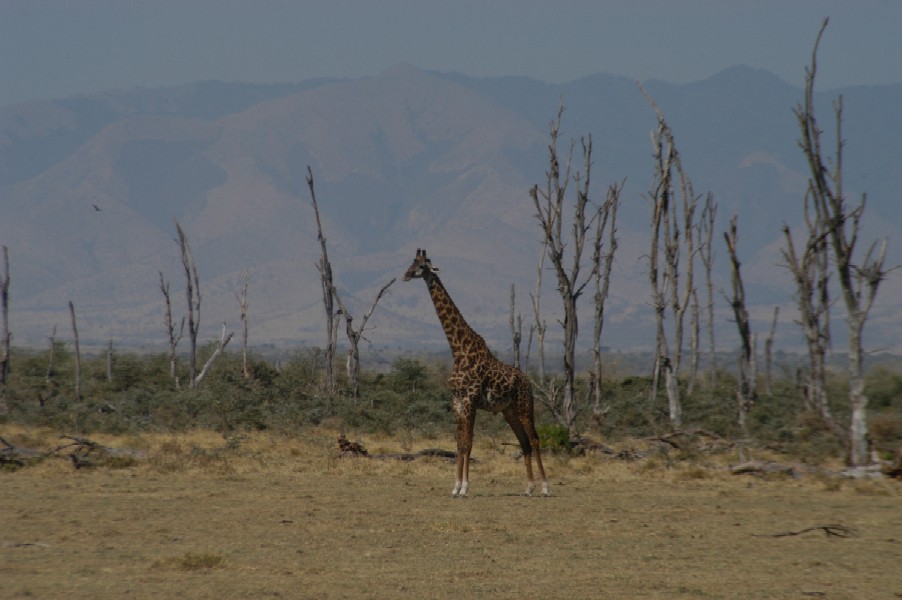 We arrived at our campsite, Twika Camp, in a Maasai village just outside Lake Manyara around 1:00. While we ate our lunch boxes, Bernard started to get the campsite set up. The roles were clearly divided. Sisti, as the guide, was supposed to be senior and he had the job of driving and pointing out animals. Bernard made our meals and set up camp. His work was more behind the scenes but I believe it was the harder of the two jobs. He had to sit in the car all day with us and then had no time to relax before or afterwards. However, local hierarchy said that they guide was more important and Sisti's slightly cocky attitude confirmed that. But, in comparison, Bernard was the more professional. We arrived at our campsite, Twika Camp, in a Maasai village just outside Lake Manyara around 1:00. While we ate our lunch boxes, Bernard started to get the campsite set up. The roles were clearly divided. Sisti, as the guide, was supposed to be senior and he had the job of driving and pointing out animals. Bernard made our meals and set up camp. His work was more behind the scenes but I believe it was the harder of the two jobs. He had to sit in the car all day with us and then had no time to relax before or afterwards. However, local hierarchy said that they guide was more important and Sisti's slightly cocky attitude confirmed that. But, in comparison, Bernard was the more professional.
At 2:00 we left with Sisti to visit Lake Manyara. The entrance was just down the street. We dropped off Bernard in town so he could buy meat for dinner. Rob told him to get a Hippo rump roast. As we made the turn I noticed a group of boys in the river next to the road. They were all stark naked and taking a bath. I laughed and commented to Sisti that when people did that back home they usually stayed away from the highway. He laughed. Rob and I amused ourselves with the small visitor's center while Sisti sorted out the fees. The roof of our truck lifted up and made into a shelter over the car where we could stand up and view animals. Lake Manyara was known for its tree climbing lions but the probability of seeing one was very low. We went in with no expectations, having heard that both Manyara and Tarangire were less exciting than the Crater and the Serengeti. The dirt road extended down the southwestern side of the long narrow lake and the surrounding area was densely vegetated. Sisti moved slowly and stopped readily when we wanted to take photos. The first group of animals that greeted us was a large family of baboons. Several of them had tiny babies clinging to their tummies or backs. They moved away from the car but were mostly unaffected by our  presence. presence.
As the road split and went towards the lake shore we saw a couple of elephants gnawing at a trees. Even after all of the elephants we had seen on our other safaris I still got a thrill watching these bulky gentle giants. Heading closer to the lake we saw small herd of impala with young, some tentatively crossing the road, others hiding in the brush. We kept our eyes peeled for lions in trees but even if they were there it would have been nearly impossible to see one in the thick green vegetation.
After passing the impalas the road opened up onto a clearing and the lake came into view. On one side there were some jagged and charred looking trees scattered close to the lake, a couple of giraffe almost blending into the backdrop. On the other side, a lone wildebeest sat pitifully alone in the middle of the clearing - one of those who didn't migrate. Closer to the lake we could see the glistening lumps of hippo backs protruding from the water. Not the most engaging animal to watch, it was an event to just see one lift its head or shift slightly. Off in the very distance was a herd of buffalo, too far to really distinguish. A number of birds were wading around and picking at bugs, a brown snake eagle was perched on a nearby branch. Off in the southern part of the lake, on the horizon, there were shades of white and pink. Vast numbers of flamingos populated the lake but kept quite a good distance from shore. The landscape was stunning with the Great Rift Valley escarpment rising up on the far side of the lake, the afternoon sun highlighting pods of wildlife here and there.
Turning away from the lake we stopped to watch a group of zebra that were standing close to the road, chewing at the short grass and drinking from the river. A few of them looked very pregnant. Behind us was a group of sixty or more baboons. One walked casually in front of the truck, grabbing bits of grass with his hand alon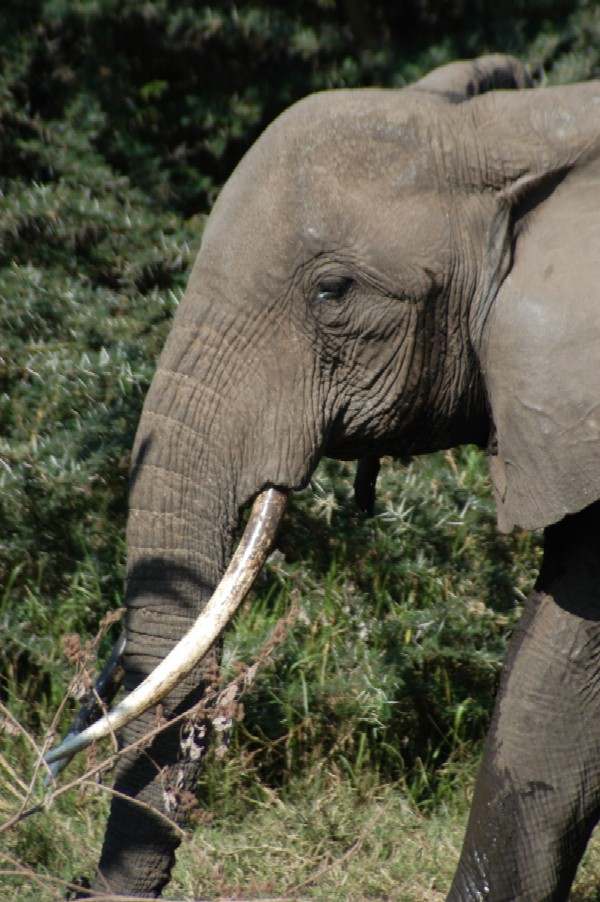 g the way. Comparing the eating habits of a zebra to that of the baboon it seemed the zebras had the more efficient strategy. Watching that poor baboon grab one tiny handful of grass after another looked like tough work. The animals existed in almost complete ignorance of the other species. g the way. Comparing the eating habits of a zebra to that of the baboon it seemed the zebras had the more efficient strategy. Watching that poor baboon grab one tiny handful of grass after another looked like tough work. The animals existed in almost complete ignorance of the other species.
From the clearing we gradually re-entered the densely vegetated part of the park. Sisti turned to keep moving southward. We had seen a couple of other trucks pass us when we entered the park but everyone had spread apart by now. Rounding a turn in the road we came face to face with a family of elephants, about six of them. The road was blocked. Sisti stopped the car. The elephants gave little reaction except for the mildly threatening spread of ears made by one member. Then they just moved right up alongside the car and went about their eating. Two of the elephants were small, the smallest keeping close to its mother. One of the larger ones moved away from the road and began ravaging a papaya tree. The animal's full body wasn't in view but we could see that doomed tree swaying vigorously in the brush, cracking noises showing the elephant's progress. Elephants have a huge food requirement and can be devastating to the environment when they are in large concentrations, which isn't a problem in East Africa where they are still struggling to increase the population. Their diet consists of many plants that yield low nutrition in proportion to the amount of work involved. This means that 40% of what elephants eat turns into waste.
Tearing ourselves away from this entertaining group, it wasn't long before we encountered a lone mother and baby tackling an acacia tree. The mother was using her trunk to yank on a branch and rip it away from the tree, the fresh fiber making it very difficult. Skittish about our presence the baby nuzzled its mother, jamming its mouth under her armpit to nurse, its little trunk flipped up over its head to get it out of the way as it searches vigorously for the source of milk. The mother swung her trunk between her legs to discourage the baby. Unhappy, it went around to the other side and tried again. After getting flicked by mom again it finally moved to the front and gave a feeble try at pulling on the tree as well, its small trunk yanking without much effect on the sinewy branch. Just precious. its mother, jamming its mouth under her armpit to nurse, its little trunk flipped up over its head to get it out of the way as it searches vigorously for the source of milk. The mother swung her trunk between her legs to discourage the baby. Unhappy, it went around to the other side and tried again. After getting flicked by mom again it finally moved to the front and gave a feeble try at pulling on the tree as well, its small trunk yanking without much effect on the sinewy branch. Just precious.
By the time we made our fourth elephant encounter we told Sisti to just keep going. They were endlessly entertaining but it was also nice to see other animals. We saw another couple of giraffes before making a stop at clearing that looked out towards the lake. The water level was low so the edge of the lake was off in the distance but the clearing meant it was safe to get out and stretch our legs. Across the flat landscape I could see an elephant swiftly moving towards the water, gently gliding with all of its ample mass.
Back on the road we returned to the tree lined area and continued south again. It was after 5:00 so we couldn't go too much farther and still make it out of the park by 6:00. Turning off on some of the narrower roads we saw a group of tiny dik diks, the smallest antelope, so small it is hard to think of it as 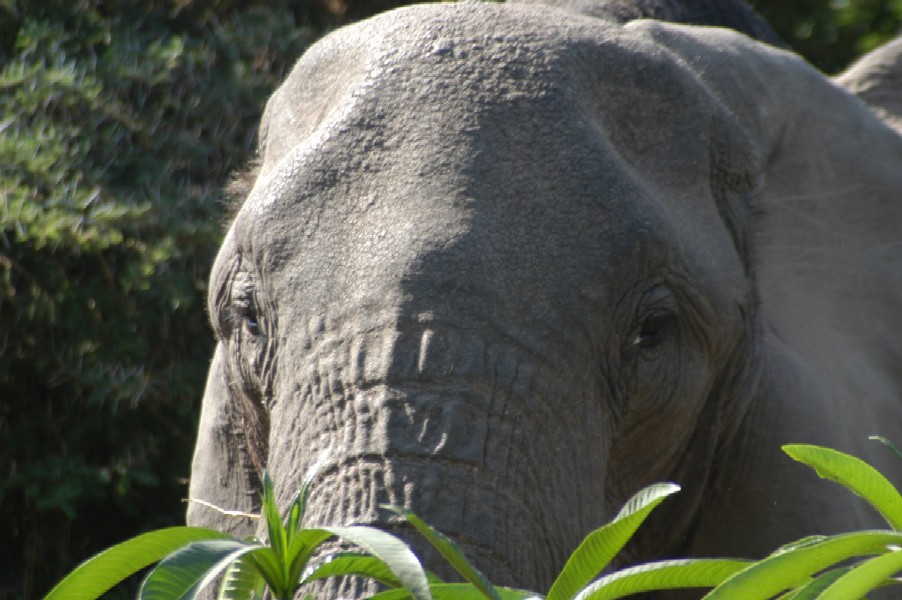 an antelope at all. They were about the size of our family poodle. As we rolled past they started to scatter but one stopped and turned to look at us, scared or curious we didn't know, but it gave a good photo opportunity. At this point Sisti turned the truck northward and we started to head towards the gate. Crossing a bridge we saw a grouping of vervet monkeys jumping through the trees, a water monitor was stretched out on the bank. The little vervet monkeys always looked like they were in a frenzy, never staying in one place very long. Two paused long enough to pick bugs off of each other while the others flitted about, glancing at us from time to time. an antelope at all. They were about the size of our family poodle. As we rolled past they started to scatter but one stopped and turned to look at us, scared or curious we didn't know, but it gave a good photo opportunity. At this point Sisti turned the truck northward and we started to head towards the gate. Crossing a bridge we saw a grouping of vervet monkeys jumping through the trees, a water monitor was stretched out on the bank. The little vervet monkeys always looked like they were in a frenzy, never staying in one place very long. Two paused long enough to pick bugs off of each other while the others flitted about, glancing at us from time to time.
Sisti picked up the pace a bit as we got closer to the gate but he still caught some hidden animals along the way. He stopped to point out a blue monkey that was jumping into the brush and then at a row of waterbucks that stood glaring at us from behind some bushes. We hadn't seen any lions in trees during our visit to Lake Manyara but it still turned out to be a very rewarding game drive. We had seen a few new species, had some excellent encounters with familiar animals, and the relative solitude of the drive was great. from behind some bushes. We hadn't seen any lions in trees during our visit to Lake Manyara but it still turned out to be a very rewarding game drive. We had seen a few new species, had some excellent encounters with familiar animals, and the relative solitude of the drive was great.
By the time we reached camp the sun was starting to go down. Bernard had set up a little table on the lawn in front of our tents and put out a selection of drink mixes, a thermos of hot water, and a plate of popcorn. The German couple, Peter and Babsi, had visited the village while we were in Manyara. In spite of horror stories about the aggressiveness of some Maasai villages they said it was fine. After sipping drinks for a while Bernard came over with a huge bowl of freshly made vegetable soup and plate of bread. How he managed to cook everything on just a grill was amazing enough but the soup was really good. For the main course he delivered a plate of steaks wrapped in tinfoil and a pot of sautéed vegetables. The steaks had been cooked in the coals with a grilled onions sauce. They were absolutely delicious, a total surprise. He even finished the meal with a plate of fruit for desert.
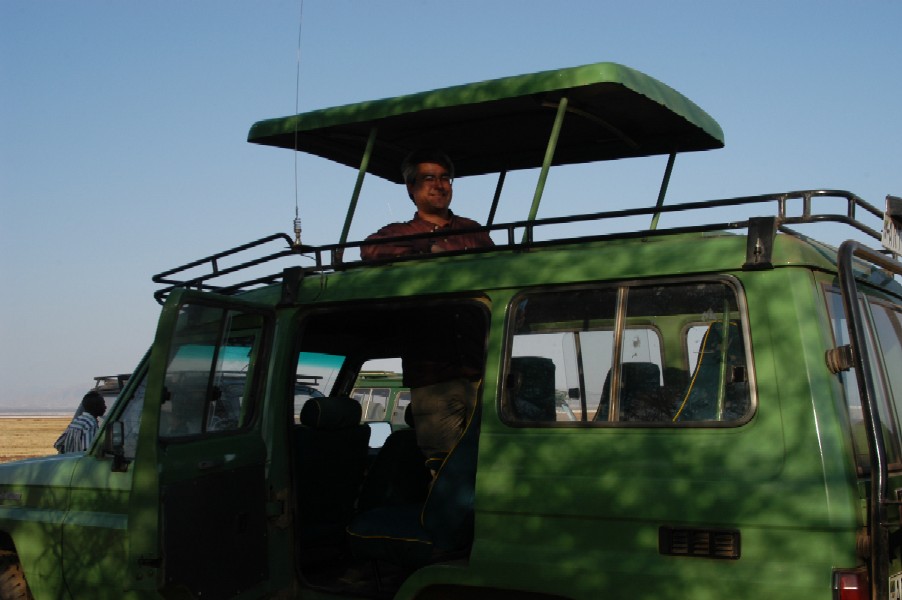 Our tents were made by Nomad but were their newer model, the ones Danie and Lucinda had told us about. They were tall enough to stand up in and there were no zipper problems. It has been about a month since we had camped but our old habits returned quickly. The campsite was full by evening and as we jockeyed for sink space in the ablutions block we recognized at least a few Americans, the REI t-shirts were a dead give away. Our tents were made by Nomad but were their newer model, the ones Danie and Lucinda had told us about. They were tall enough to stand up in and there were no zipper problems. It has been about a month since we had camped but our old habits returned quickly. The campsite was full by evening and as we jockeyed for sink space in the ablutions block we recognized at least a few Americans, the REI t-shirts were a dead give away.
|

